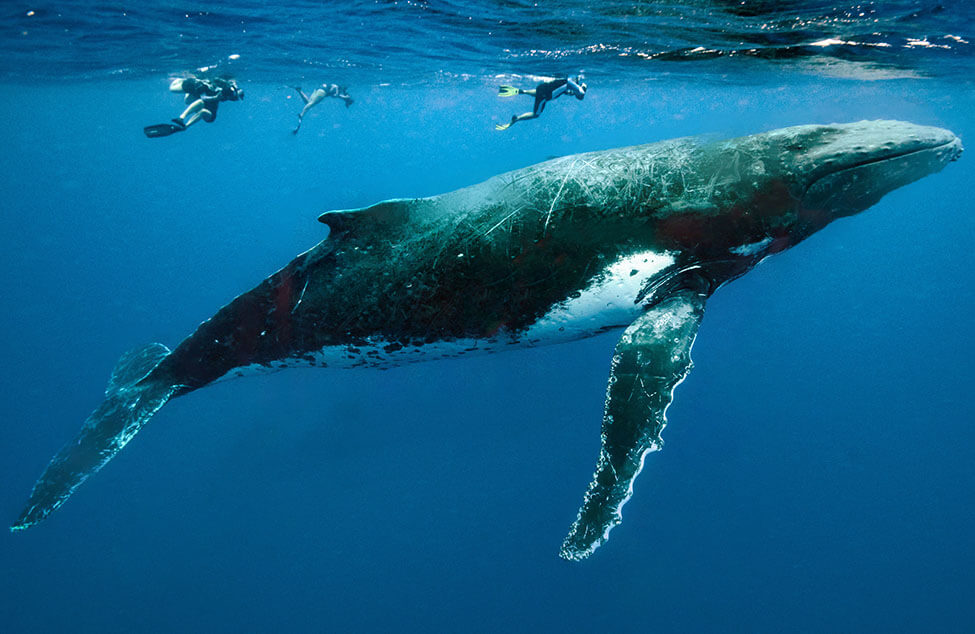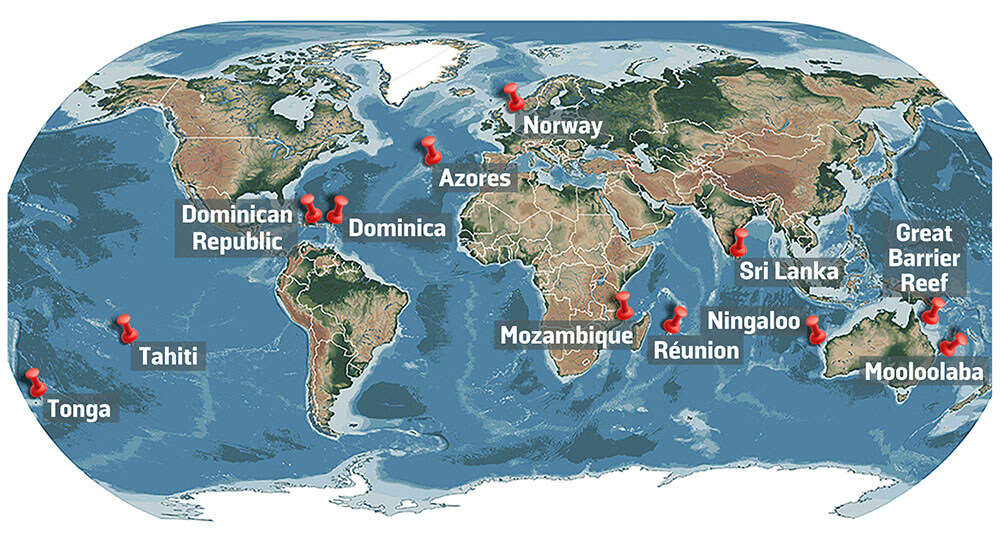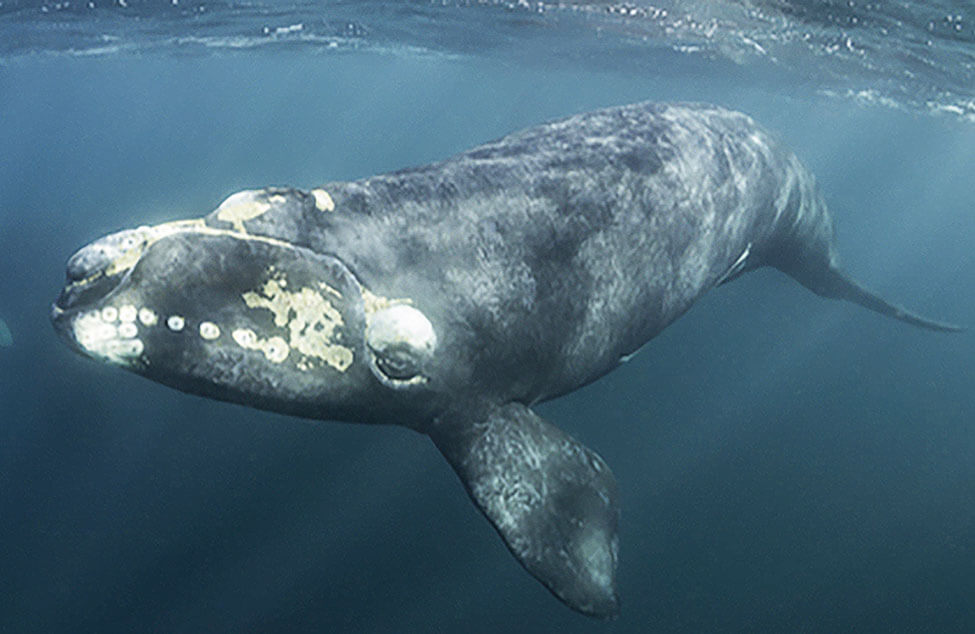
DIVE Magazine Special Report
Swimming with whales and other large animals is one of the most important driving forces behind marine conservation – the idea that marine megafauna is worth more as a living tourist attraction than it is dead on a local market stall. Changing the perception of sharks, manta rays and other large species from ‘food’ to ‘entertainment’ prevents the animals from being slaughtered, and provides valuable income for those who would otherwise be slaughtering them.
As a result, tours allowing people to swim and snorkel with whales are becoming increasingly popular around the world, which presents a new challenge to megafauna conservation: more people wishing to swim up close and personal with some of the largest creatures that have ever existed means more boats, more danger to the animals, and an increasing threat to whale populations through behavioural change due to poor interactions and disreputable operators.
We take a look at the various locations around the world where swimming with whales is on offer. If you know of other locations and would like to share your experiences, please get in touch using the address at the end of the article.

Azores
Approximately 1,000 miles out into the Atlantic Ocean from mainland Portugal, the Azores (or Açores, in Portuguese) are visited by an incredible array of marine life, and especially megafauna. Along with whale sharks and a number of different dolphin species, sperm whales are present in the area from June until September. Government permits are required in order to allow people to swim with the animals, with strict rules concerning the number of people allowed in the water and for how long. Permits are never issued during calving season in July and August. The majestic Blue Whale also passes through the Azores in March and April.

Dominica
The island of Dominica, part of the Lesser Antilles and situated towards the furthest reaches of the Caribbean Sea, sees a number of cetaceans visit throughout the year. Humpback whales, false killer whales and pilot whales are regularly spotted, but it is the population of sperm whales that draws many visitors to Dominica. It is one of the only locations in the world where sperm whales can be sighted all year round, although they are most common from November through to March. The resident population is comprised almost exclusively of females and their calves, as older males tend to live solitary lives. Dominica has a strict allocation of whale-watching permits, issued to a very limited number of operators, and regulations are strictly enforced.
Dominican Republic
Silver Bank, around 90km north of the Dominican Republic, plays host to almost the entire population of North Atlantic humpback whales during their migration each year. Officially designated the ‘Sanctuary for the Marine Mammals of the Dominican Republic,’ Silver Bank is a marine sanctuary where, between January and April, the whales gather to shelter, mate, feed, and rear their young. As with other nationally protected areas, permits to operators are issued on a very limited basis and regulations for whale interaction are rigidly adhered to and enforced; there is also a substantial fee to enter the marine park.
Mooloolaba
Humpback whales migrate along the eastern coast of Australia every year between July and November, and Mooloolaba in Queensland is perfectly placed to offer whale interaction tours. Australia has strict guidelines for whale and dolphin watching and operators have an established and comprehensive code of conduct governing interactions. The number of boats in an area in which whales are present is limited and they must maintain continuous radio contact; engines must be put into neutral should a whale be spotted within 100m of the vessel, with additional precautions taken should a calf be present. All interactions that involve swimming with whales are briefed in detail and supervised by trained staff.
Great Barrier Reef
Dwarf minke whales are commonly spotted along the Great Barrier Reef during the months of June and July. They are curious and seemingly very friendly animals. The whales will often approach from a distance, getting closer and closer before choosing to interact closely with people in the water. Regulations require that operators allow only snorkellers into the water when the whales are present, who must hold a trailing rope at all times. The regulations are strictly enforced and encounters enjoyable.
Ningaloo
June to November sees the western Australian migration of humpback whales, and Ningaloo Reef, near Exmouth in Western Australia, sees the highest density of humpbacks gathered in the southern hemisphere each year. Humpback interaction tours are available from August to November, and as with other locations in Australia, are governed by a comprehensive set of regulations covering swimming with whales which are strictly enforced.
Norway
A number of different whale species can be found off the coast of Norway, and plenty of whale-watching boat trips are available – but there are a few specialist companies offering snorkelling trips for hardy folk (drysuits usually included) between November and March each year. Huge schools of herring arrive in Norwegian waters over the winter, bringing with them large numbers of humpbacks and fin whales. Orcas, commonly called ‘killer whales’ (although they are actually a species of dolphin) also join in the feast, and a small number of operators offer dedicated orca snorkelling trips (with whales highly likely) during the season. Needless to say, swimming in the Arctic in winter with killer whales presents a number of challenges, and local regulations and strict codes of conduct are enforced during whale and orca snorkelling trips.
Réunion
A small volcanic island in the Indian Ocean, Réunion lies on the migratory route of humpback whales during the southern winter. Each year between July and November, the whales gather to breed and calf and are mostly seen along the island’s west and southwestern coastlines. At the time of writing, there do not appear to be any governmental legislation in place regarding whale-watching tours, although various environmental bodies such as Globice have developed an ‘Approach Charter’ which is adhered to by responsible tour operators.
Mozambique
Humpback and southern right whales migrate towards warmer waters from their summer Antarctic homes between July and December each year. Both species can be spotted around Mozambique during this time, but peak season is during August and September. A number of operators offer snorkelling trips during this time, and local regulations are strictly enforced.

Tahiti
The annual migration of humpback whales arrives in Tahiti at the beginning of July, where the animals will remain until early November, although the population is far more numerous between August and October. Cetaceans have been protected in French Polynesian waters since 2002, an area covering almost 5 million sq km of ocean, the largest marine sanctuary in the world. As a result, codes of conduct for whale interactions are firmly established in place and any regulations are strictly enforced.
Sri Lanka
Blue whales are spotted around Mirissa between November to April, and sperm whales visit Trincomalee & Kalpitiya each year between May to September. The last few years have seen a massive surge in whale watching tours around Sri Lanka. In just one of the resorts catering for whale trips the growth has been staggering – in 2011 the total number of whale-watching boats in Kalpitiya was just three; by 2019, a huge increase in the number of tourists swimming with whales had increased the number to 90. Although a government permit is required to swim with whales, the regulations are rarely enforced. Illegal operators often compete to out-manoeuvre each others’ boats and drop their tourists as close to the whales as possible, causing the whales to retreat and preventing any chance of interaction. See our World Editor Douglas David Seifert’s report on swimming with whales in Sri Lanka.

Tonga
As Tonga became an increasingly popular tourist destination, local operators began to take advantage of the humpback whale population during the peak season from July to October. Initially unregulated, with too many boats and no guidelines for interaction, the government took notice of the problem and, in 2013, began the Tonga Whale Guide Training Programme. Operators must be licensed for whale interaction tours, and reputable companies are keen to raise awareness among tourists by adhering to a code of conduct during excursions. However it has been reported that too many licenses may have been granted, and there is ‘little control on the water’ as less reputable operators ignore the code of conduct. Regulations are not strictly enforced, but the best operators are leading by example. Tonga is currently off-limits for tourists due the recent volcanic eruptions and also for Covid-19 reasons. We will update as the position changes.
Have you had a whale-watching experience that you’d like to share with us? Was it an amazing experience with respect for the animals’ welfare or was it a chaotic free-for-all where any kind of rules was abandoned for cash? We’d like to hear your stories and reviews so that we can create an up-to-date list for tourists, divers and underwater photographers to use as a resource to locate the best and most environmentally aware operators – and avoid those who don’t play by the rules. Get in touch at info@divemagazine.com


